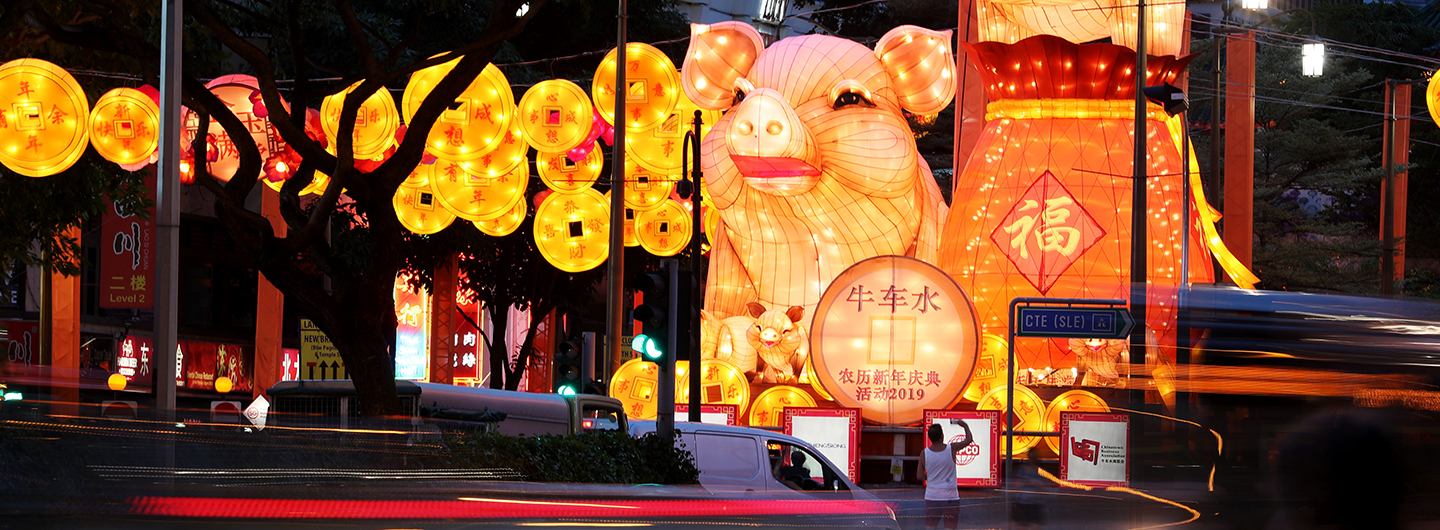In his 2019 Chinese New Year Message, PM Lee Hsien Loong spoke about how the Singapore Chinese identity has evolved and emerged over the years, and will continue to do so.
This year, we are commemorating the Singapore Bicentennial. 200 years ago, Stamford Raffles arrived in Singapore. That marked a crucial turning point in our history, including for our Chinese community. While Chinese junks had traded in Singapore as far back as the 14th century, large-scale immigration started only after Raffles established a free port here.
Chinese immigrants came from as close by as Malacca and as far away as Canton, Swatow and Amoy. Like other groups, the Chinese came to seek their fortunes and support loved ones back home. Some immigrants eventually returned to their home villages. But many stayed, and gradually made Singapore their home.
Most immigrants arrived in Singapore in debt, and did back-breaking work here as plantation workers and coolies. When Chinese New Year came, they were too poor to travel back home. Instead, they celebrated with fellow labourers and clan members in Chinatown, and re-created whatever traditions they could – eating auspicious foods, performing lion dances for good fortune, and setting off fire crackers to drive away evil spirits.
Over the years, Chinese Singaporeans developed our own unique rituals and traditions celebrating Chinese New Year, which were passed down the generations. Today, at reunion dinners, we do lohei (捞鱼生) to express our hopes and wishes for the coming year. When visiting friends and relatives, we enjoy pineapple tarts, kueh lapis spekkoek and kueh bangkit, a reflection of the Southeast Asian heritage of the Straits Chinese. In the 1970s, we stopped letting off firecrackers at homes and along the streets, because in a built up and dense city, this was dangerous to people and property. In their place, to kindle the festive mood, we started holding Chingay Parades (妆艺大游行) from 1973.
The Chingay Parades were inspired by the pre-war Chingay processions in Penang to celebrate temple festivals. The first few featured mainly Chinese cultural items – lion and dragon dances and traditional performances. But since then Chingay has grown into a celebration for people of all races and ages. Chinese lion dancers perform alongside Malay children playing the kompang and Indian dance troupes classical and modern. All our ethnic cultures contribute items. International groups too, participate, coming all the way from Japan, Russia or China. Every year, thousands of Singaporeans young and old look forward to taking part in and watching the Chingay Parade. The involvement of all races adds a special joy and richness to the festivities, and reflects our unique multicultural society. We see this happening also when the Chinese join in Hari Raya celebrations with our Muslim friends, and Deepavali festivities with our Hindu friends.
The way we celebrate Chinese New Year reflects how the Singapore Chinese identity has evolved and emerged over the years. Chinese Singaporeans have integrated into a larger, multiracial whole. In the process Singaporean Chinese have become distinct from Chinese communities elsewhere, both the Chinese societies of China, Hongkong and Taiwan, and the overseas Chinese minorities in the diaspora in Southeast Asia and the West.
But identity, like tradition, is dynamic. As new generations come of age and new immigrants join us, the Singaporean Chinese identity will keep on evolving. The new arrivals will enrich our cultural heritage with their different life experiences and perspectives. At the same time, I hope that over time they will adjust their social norms to our local context, and embrace our uniquely Singaporean cultural habits, just as earlier generations did. This is the way for the Chinese community to stay vibrant, and for Singapore to be open, dynamic and resilient for many years to come.
I wish all Singaporeans a happy and prosperous Chinese New Year.
2019 年总理新春献词
今年正逢新加坡开埠200周年纪念。莱佛士在两个世纪前登陆新加坡,这是我国历史上的一个关键转捩点,对本地华社而言亦是如此。中国商人虽然早在14世纪元朝时代就已经扬帆南下,来到新加坡经商,但华人大举过番,并且在这里落户,其实是在英国人把新加坡开辟为一个自由港后才开始的。
当时的华族移民,有的是从毗邻地区如马六甲,有些则是从中国南方地区如广东、汕头和厦门等飘洋过海来到这里。就如其他移民一样,这些华族移民离乡背井,大多数是为了寻求生计,赚钱养活远在家乡的妻儿老小。有些后来选择“返唐山”(返回家乡),但多数还是选择在此成家立业,以新加坡作为安身立命的家园。
当时,很多移民都背负着债务,到了新加坡,为了谋生就在甘蜜和胡椒园辛勤耕种,或是在码头当苦力,从事艰苦的体力活。到了农历新年,他们没有足够的积蓄,不可能回乡与家人团聚,只能与住在牛车水一带的其他苦力和同乡聚在一起欢庆佳节。在庆祝这个重要的华人节日时,先辈们延续着自己家乡的传统习俗,例如吃年菜讨个吉利,以舞狮表演助兴,和燃放炮竹驱走厄运,祈望新的一年兴旺发达。
这些年来,新加坡华人形成了具有本土特色的新年习俗,并将这些习俗一代又一代地传承下去。比如,我们会在新年期间与亲友或同事一起捞鱼生,希望捞个好彩头,一整年顺顺利利。拜访亲友时,我们也会品尝各种具有东南亚土生华人文化特色的糕点,包括黄梨挞,千层糕和kueh bangkit等。然而,在70年代,由于我国逐渐成为一个人口稠密的城市,为了安全起见,政府决定禁止人们在家里和路边燃放炮竹。所以,从1973年开始,政府就通过举办妆艺大游行,代替被禁的燃烧炮竹活动,为农历新年增添热闹气氛。
妆艺大游行启发自二战前槟城庙会的花车游行。早期的几个妆艺大游行表演的节目以华族文化为主,有舞狮、舞龙,以及其他传统武术与舞蹈表演。时至今日,妆艺大游行已经蜕变成一个汇聚全国各族,不论年龄、不分种族,同欢共乐的活动。在活动上,我们可以看到华族醒狮团、拍着手鼓 (kompang) 的马来小朋友、踏着古典和现代舞步的印族舞蹈员同台表演。此外,日本、俄罗斯和中国等世界各地的表演者也远道而来参与其中,为这个庆典增添异国色彩。数千名各种族国人每年都期待观赏或参与妆艺大游行,共同沉浸在浓浓的节日气息。各大种族的参与为新春佳节平添一份特殊的喜气,也展现了我国丰富多彩的文化。这就是我们这个多元文化社会的独特之处,各族人民共庆彼此的重大节日。就如每逢开斋节时,本地华族同胞也会和回教徒朋友一起庆祝,在屠妖节时,我们也会与兴都教同胞一起欢度。
此外,我们庆祝农历新年的方式,也反映了这些年来,本地华族已经建立了独特的新加坡华人身份,并且完全融入更广大的多元种族社会,进而使新加坡华人有别于其他地区的华人,包括两岸三地的华人、以及东南亚和西方国家的华裔。
尽管如此,这个独特的华人身份就像传统习俗一样,会随着时代一直改变。随着新一代的华人长大成人还有新移民的加入,新加坡华人的身份将继续演变。新移民将带来不同的人生经历和新的视角,使我国的文化遗产更加丰富。我希望他们假以时日,也会像我们的先辈一样入乡随俗,接受这里的社会规范,积极融入本地社会。这样一来,本地华社将会更有活力,也确保我国在持续开放的同时,继续保持团结一致,朝气蓬勃。
祝全体国人新年快乐,万事如意!
Explore recent content
Explore related topics

